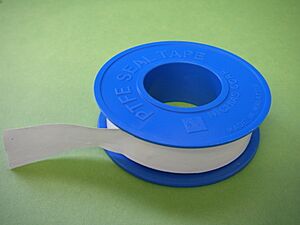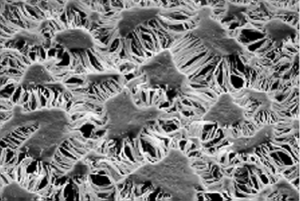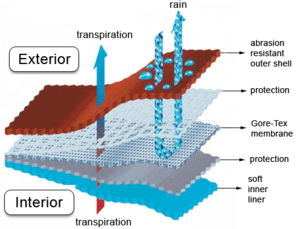Robert W. Gore facts for kids
Quick facts for kids
Robert W. Gore
|
|
|---|---|
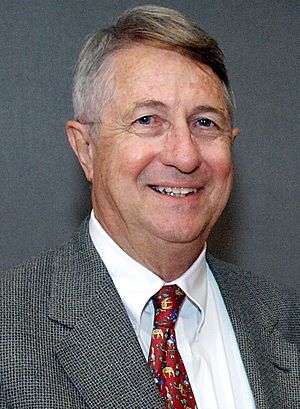
Gore at the Chemical Heritage Foundation in 2005
|
|
| Born | April 15, 1937 Salt Lake City, Utah, U.S.
|
| Died | September 17, 2020 (aged 83) Earleville, Maryland, U.S.
|
| Alma mater | University of Delaware, University of Minnesota |
| Scientific career | |
| Fields | Chemical engineering |
| Institutions | W. L. Gore & Associates |
Robert W. Gore (born April 15, 1937 – died September 17, 2020) was an American engineer, scientist, inventor, and businessman. He led his family's company, W. L. Gore & Associates. Under his leadership, the company created many useful products from a special plastic called polytetrafluoroethylene (PTFE). These products included computer cables, medical devices, and even parts of space suits.
His most famous invention was probably Gore-Tex. This amazing fabric is waterproof but also lets your skin breathe. It's super popular for outdoor clothing and sports gear.
Contents
Robert Gore's Early Life and School
Robert Gore was born in Salt Lake City, Utah on April 15, 1937. His parents were Wilbert "Bill" and Genevieve "Vieve" Gore. In 1950, his family moved to Newark, Delaware. They wanted to be close to his father's job at the DuPont company. Bob started school in Newark when he was in eighth grade.
He went to the University of Delaware and earned a bachelor's degree in chemical engineering in 1959. After that, he moved with his wife and son to attend graduate school. He continued his studies at the University of Minnesota. There, he earned his master's degree and then a PhD in chemical engineering in 1963.
Inventing the Multi-Tet Cable
While Bob's father, Bill Gore, worked for DuPont, he also experimented at home. He used materials like Teflon polytetrafluoroethylene (Teflon PTFE). Bill wanted to use PTFE to cover electrical wires. However, coating wires with PTFE powder didn't work very well.
In April 1957, when Bob was still in college, his dad showed him his home lab. Bill explained the problem he was having with the wires. Bob had a great idea! He suggested using a different form of PTFE, a white tape that was already a perfect thickness. His father thought the tape wouldn't stick, but he tried it, and it worked!
They placed wires between layers of PTFE tape. Then, they sent them through a special machine that heated and melted the tape. This created a smooth, strong coating. The result was a ribbon cable with many copper wires inside. They called it "Multi-Tet Cable."
Starting W. L. Gore & Associates
Solving the Multi-Tet Cable problem was a big deal. It led Bob's parents, Bill and Genevieve, to start their own company in 1958. They named it W. L. Gore & Associates. For the first two years, the business was run from the basement of their family home. Robert Gore lived upstairs with his parents, other family members, and even some employees! At one point, 13 out of 16 company workers lived in the Gore house.
The company's goal was to use and develop technology with fluorocarbon polymers, especially PTFE. They believed these materials could greatly help society.
The Multi-Tet cable was the first big product for the new company. Bob Gore was listed as the inventor on the company's first patent in 1958. Multi-Tet cable was used in early computers like the IBM System/360. It was also used in communication and control equipment. The company even provided cables for the Surveyor satellites and the Apollo space missions. During the Apollo 11 mission, astronauts used a Gore cable to connect their spaceship to a seismograph on the Moon.
Bob Gore joined the company's board of directors in June 1961, while he was still a student.
Robert Gore's Innovations and Leadership
After getting his PhD in chemical engineering in 1963, Gore joined W. L. Gore & Associates as a research associate. By 1967, he became the company's leader for technical research.
Inventing Gore-Tex
In 1969, Gore was working on a way to stretch PTFE plastic into tape for pipes. He made an amazing discovery! He found that the plastic could be "expanded" into a porous form of PTFE. This new material was incredibly strong and full of tiny holes.
He and others had tried to stretch PTFE rods by a small amount, about 10%. But Bob's discovery was a happy accident. Instead of stretching the heated material slowly, he gave it a sudden, quick pull. The solid PTFE stretched an incredible 800%! It formed a material that was about 70% air, with a microporous structure.
He filed a patent for this expanded PTFE in 1970. Later, two patents were given: one for the product itself and one for the process of making it.
Gore kept studying this new material. He worked with others to find ways to stretch it in one direction to make long threads. They also stretched it in two directions to create sheets of the material. Stretching it in two directions made the sheets even stronger and more breathable. This opened up many new uses for the material.
By 1971, Gore was experimenting with combining the stretched material with other fabrics. This created a waterproof material called expanded polytetrafluoroethylene (ePTFE). Today, it is known by its famous brand name, Gore-Tex.
Medical Uses for Gore-Tex
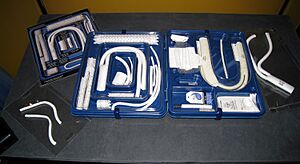
Some of the first successful products using Gore-Tex were burn bandages. They also made special filters for liquids and membranes for blood oxygenation machines.
Gore-Tex is very useful inside the human body because it doesn't react with body tissues. Also, the tiny holes in Gore-Tex allow the body's own tissue to grow through the material. This helps grafted materials become a part of the body's circulation system.
Gore-Tex as Waterproof Fabric
Most people know Gore-Tex as a waterproof, breathable fabric. It's used in outdoor clothing and sports shoes. To the eye, it looks and feels like a smooth fabric. But if you look closely, the fabric has about nine billion tiny holes per square inch!
These holes are big enough for body heat and sweat vapor to escape. But they are too small for water drops from rain or snow to get in. This means rain and snow can't make you wet, but your perspiration can escape as it evaporates.
The first time Gore-Tex was used to make waterproof clothes was in 1972. The process for making it was patented that same year. The first Gore-Tex products sold were tents in 1976. The next year, rainwear made with Gore-Tex was sold.
Gore-Tex is usually placed between an outer fabric and an inner lining. The material allows moisture to move easily from one layer to the next. This process is called wicking. This, along with a special coating that repels water, helps keep the wearer dry and warm. Since 1989, Gore has allowed other companies to use Gore-Tex in their products. However, these products must pass tough tests in Gore's special rain room, and also abrasion and washing tests.
Robert Gore's Role as Company Leader
Robert Gore became the president and CEO of W. L. Gore & Associates in 1976, taking over from his father. The company stayed in Newark, Delaware, but grew all over the world. They developed Gore's original ideas into four main product areas: fabrics, medical, industrial, and electronic products. The company is also known for its unique management style.
In 2000, Gore stepped down as president. He became the chairman, a position he held until 2016.
Robert Gore's Personal Life
Robert Gore married Sarah Louise "Sally" Coons in 1977. She had three sons. One of her sons is Chris Coons, who is now a United States senator from Delaware. Chris Coons worked for several years as a lawyer for the Gore family company.
Robert Gore passed away on September 17, 2020, in Earleville, Maryland.
Giving Back to the Community
Robert Gore cared a lot about his old schools, the University of Delaware and the University of Minnesota. He helped them by serving on their boards and giving many gifts. These gifts helped build new buildings and create special programs for students. For example, the Gore family gave money for Gore Hall at the University of Delaware. They also helped fund the Genevieve W. Gore Recital Hall and the Robert W. Gore Fellowship. At the University of Minnesota, his gifts helped build the "Gore Annex" and the "Bob and Jane Gore Research Laboratories."
Awards and Recognition
Robert Gore was recognized for his amazing work.
- In 1995, he was chosen for the National Academy of Engineering for his technical achievements.
- In 2003, he received the Winthrop-Sears Medal for his entrepreneurial success in the chemical industry.
- In 2005, he was awarded the Perkin Medal for improving the quality of life and helping the U.S. economy.
- In 2006, he was added to the American National Inventors Hall of Fame for inventing Gore-Tex.
He also received an honorary doctorate degree from Heriot-Watt University in 2001.
Images for kids


